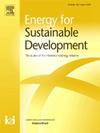Roadmap toward carbon neutrality in Pakistan: Policy challenges and strategic measures
IF 4.9
2区 工程技术
Q2 ENERGY & FUELS
引用次数: 0
Abstract
Stabilizing global mean temperature requires all countries to align with pathways that achieve carbon neutrality by the middle of the century. For late-industrializing economies, this objective is particularly demanding, since their energy demand and emissions continue to rise. This study provides a systematic assessment of Pakistan, a country ranked among the most climate-vulnerable globally and lacking a defined pathway to mid-century carbon neutrality. The analysis first establishes clear conceptual distinctions among carbon neutrality, net-zero greenhouse gases, and climate neutrality, terms that are often used interchangeably in international policy debates. Using a backcasting framework, we establish 2050 carbon neutrality as the target year and identify the intermediate stages required for convergence. The analysis integrates national energy and emissions data (2013−2023), international statistical reviews, and comparative trajectories from the European Union, the United States, and regional peer economies. The results outline a three-stage, four-step strategy that incorporates accelerated electrification, industrial decarbonization, renewable energy expansion, circular economy practices, and natural sequestration. Our findings demonstrate that a late peaking (≈2030) can still converge to carbon neutrality by mid-century, provided that policy alignment and investment mobilization occur within the next decade. This framework informs transition strategies across similarly placed economies.
巴基斯坦实现碳中和的路线图:政策挑战和战略措施
稳定全球平均气温要求所有国家在本世纪中叶实现碳中和。对于工业化后期的经济体来说,这一目标要求特别高,因为它们的能源需求和排放量继续上升。这项研究对巴基斯坦进行了系统评估,巴基斯坦是全球最易受气候影响的国家之一,缺乏实现本世纪中叶碳中和的明确途径。该分析首先明确了碳中和、净零温室气体排放和气候中和之间的概念区别,这些术语在国际政策辩论中经常互换使用。使用回溯框架,我们将2050年碳中和确定为目标年,并确定趋同所需的中间阶段。该分析综合了各国能源和排放数据(2013 - 2023年)、国际统计评估以及欧盟、美国和区域对等经济体的比较轨迹。结果概述了一个三阶段、四步骤的战略,其中包括加速电气化、工业脱碳、可再生能源扩张、循环经济实践和自然封存。我们的研究结果表明,如果在未来十年内实现政策协调和投资动员,到本世纪中叶,后期峰值(≈2030年)仍然可以趋近于碳中和。这一框架为处境相似的经济体的转型战略提供了信息。
本文章由计算机程序翻译,如有差异,请以英文原文为准。
求助全文
约1分钟内获得全文
求助全文
来源期刊

Energy for Sustainable Development
ENERGY & FUELS-ENERGY & FUELS
CiteScore
8.10
自引率
9.10%
发文量
187
审稿时长
6-12 weeks
期刊介绍:
Published on behalf of the International Energy Initiative, Energy for Sustainable Development is the journal for decision makers, managers, consultants, policy makers, planners and researchers in both government and non-government organizations. It publishes original research and reviews about energy in developing countries, sustainable development, energy resources, technologies, policies and interactions.
 求助内容:
求助内容: 应助结果提醒方式:
应助结果提醒方式:


